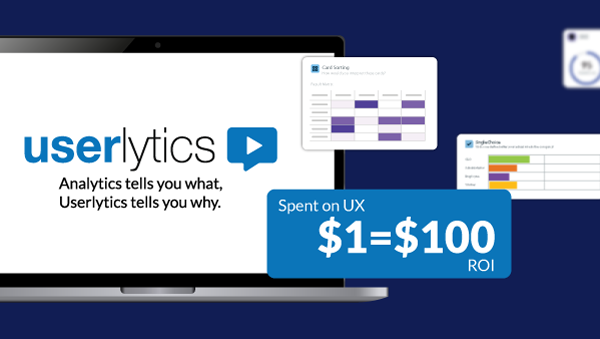One Platform, Endless User Insights
Test ideas, validate designs, and uncover hidden friction points, all with global panel access and expert support. Userlytics is the flexible, all-in-one UX research platform built to optimize digital experiences and deliver measurable results.

Trusted by Global Leaders
The fastest path to great user insights, all in one platform
Run studies in 150+ countries and 30+ languages. With access to over 2M+ participants, you can capture truly representative insights across markets, not just English-speaking audiences.
Give your entire team access without extra fees. Unlimited admin seats, so cross-functional collaboration never gets stuck behind budget barriers.
Run moderated and unmoderated studies, card sorting, tree testing, surveys, analysis and more in one centralized location.
Our proprietary ULX Benchmarking Score delivers a standardized metric for user experience. Give stakeholders a clear, comparable KPI that ties UX performance directly to business outcomes.
Our hybrid SaaS + consulting model solves limited in-house research capacity. Tap into our UX consultants, project managers, and account managers to support study design studies and execution flawlessly when your internal capacity is limited.
Even the most niche and hard-to-reach demographics are possible here. We can recruit the right participants and support advanced methodologies like longitudinal testing and multi-market studies.
From quick design sanity checks to in-depth research & validation
From prototype to production to iteration, these features help you test every stage of your product.
What our Customers Have to Say
Exceptional Participants, Seamless Platform — Userlytics Delivers Meaningful Insights
“Userlytics turned out to be incredibly intuitive. The platform guides you through setup with clear, simple steps that make even first-time users feel confident and in control. But what has truly amazed me — and what sets Userlytics apart — is the caliber of participants.”
EM
Erica M.
High-Quality User Feedback Instantly
"Userlytics allows us to receive user feedback on products instantly. A typical process would involve pitching multiple research agencies, reviewing their pitches, signing a contract, fielding participants, etc. At least a 2-month process."
DK
Derrick K.
A Game-Changer for Quick, Insightful UX Research in a Fortune 500 Company
“Userlytics has been an amazing tool for our UX research. It’s easy to use, helps me set up tests quickly, and provides valuable feedback. The video recordings are a great way to see how users interact with our websites, and the insights have been eye-opening.”
MR
Manuel R.
Absolutely Phenomenal - 10 Stars!
Userlytics transformed our testing procedures. Сustomer support is responsive.
The platform is an extensive toolkit encompassing all the necessary features for testing projects, from usability testing to prototype evaluation: perfect design and user-friendly interface.
MB
Maksym B.
Excellent customer support, easy to use and excellent participant panel
“We use Userlytics because we know we will be able to find excellent participants quickly that provide in-depth feedback on our designs. The tool itself is easy to use and has some…
JL
Jennifer L.
Get smarter about user research through our curated Resources
ChatGPT, Claude, or DeepSeek? See which LLM stands out in UX and why! Powered by real user data and our ULX® Benchmarking Score.
Discover 'The State Of UX In 2025' report: Key insights on UX research evolution, roles of product managers, and future trends.
ROI de las Pruebas de Usabilidad Web: Herramientas y Consejos 2025 (ES)
Studies show chatbot success depends on UX, not code. We help teams design successful AI chatbots that people trust, love, and return to.
Born Digital: How AI-Native Research Is Rewriting UX. Discover how AI-native research is revolutionizing user insights.
Learn how real-world product teams apply the continuous discovery framework, overcome challenges, and make smarter product decisions.
Join Nate Brown, Taylor Bras and Lindsey Ocampo in the podcast Bridging UX Education & Stakeholder Relationship to unpack the critical skills needed to succeed in a modern UX career.
Join Nate (Userlytics) and Arun Ramakrishnan in this podcast to explore more about Global Accessibility Awareness Day.
How Duluth Scaled UX Research with Userlytics’ team.
QuillBot Democratizing Research with Userlytics
Userlytics Introduces New Features and Joins Inc.5000. Ranked No. 2871 on this year’s Inc. 5000 list.
Catalyzing User-Friendly Digital Spaces An Exclusive Interview with Alejandro Rivas Micoud, CEO of Userlytics.
Discover how users instinctively navigate and interact with your website, revealing insights to optimize experience and boost conversions.
Gain insights into how users organize and categorize information with card sorting, helping you create intuitive, user-friendly navigation.
Make User Feedback your Vantage Point
There’s no need to guess about user experience. Schedule a demo and see how easy it is to get meaningful feedback from real users. Your first insights are hours away.